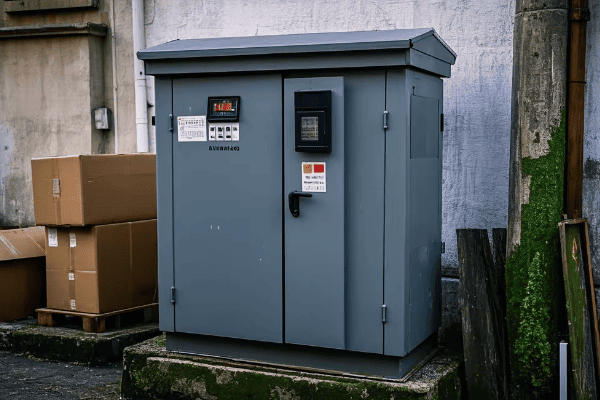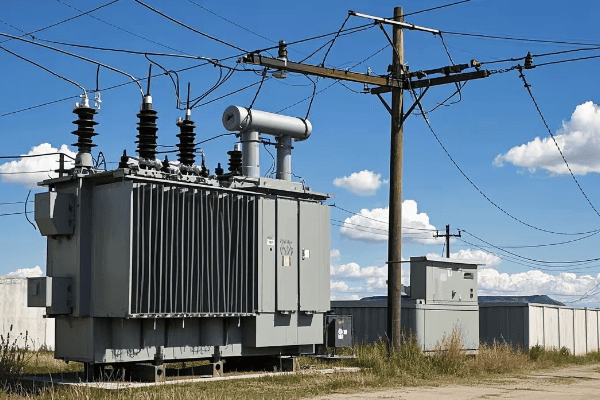Electronic Transformers: Revolutionizing Power Conversion in Modern Devices?
Have you ever wondered how your sleek smartphone charges so quickly or how your laptop stays cool despite its powerful performance? The secret lies in a tiny but mighty component: the electronic transformer.
Electronic transformers are revolutionizing power conversion in modern devices. They use advanced semiconductor technology to convert and control electrical power more efficiently than traditional transformers. This innovation enables smaller, lighter, and more energy-efficient electronic devices.

As an electrical engineer with years of experience in power electronics, I’ve witnessed firsthand the impact of electronic transformers on our everyday devices. Let’s explore how these small wonders are changing the game in power conversion technology.
Electronic vs. Traditional Transformers: A New Era in Power Conversion Technology?
Remember those bulky chargers we used to have? The shift to sleek, efficient power adapters is thanks to electronic transformers. But how do they differ from their traditional counterparts?
Electronic transformers use semiconductor switches and high-frequency operation to convert power, unlike traditional transformers that rely on electromagnetic induction. This allows electronic transformers to be smaller, lighter, and more efficient, marking a new era in power conversion technology.

Let’s dive deeper into the key differences:
1. Operating Principle
Traditional Transformers:
- Use electromagnetic induction
- Operate at low frequencies (50-60 Hz)
Electronic Transformers:
- Use power electronics (switches, capacitors, inductors)
- Operate at high frequencies (20 kHz to 1 MHz)
2. Size and Weight
The high-frequency operation of electronic transformers allows for significant size reduction:
- Traditional transformers often weigh several kilograms
- Electronic transformers can weigh just a few grams
3. Efficiency
Electronic transformers generally offer higher efficiency:
- Traditional transformers: 85-95% efficient
- Electronic transformers: Up to 98% efficient
4. Voltage Regulation
Electronic transformers provide better voltage regulation:
- They can quickly adjust to load changes
- They offer more precise output control
Here’s a comparison table:
| Feature | Traditional Transformer | Electronic Transformer |
|---|---|---|
| Size | Large | Compact |
| Weight | Heavy | Light |
| Efficiency | 85-95% | Up to 98% |
| Frequency | 50-60 Hz | 20 kHz – 1 MHz |
| Voltage Regulation | Limited | Precise |
| Cost | Lower | Higher (but decreasing) |
I remember working on a project to redesign a power supply for a medical device. By switching from a traditional to an electronic transformer, we reduced the device’s weight by 40% and improved its efficiency by 5%. The medical staff were thrilled with the more portable and reliable equipment.
The shift from traditional to electronic transformers represents a significant leap in power conversion technology. While traditional transformers still have their place in high-power applications, electronic transformers are becoming the go-to solution for modern, portable electronic devices. They’re not just a component; they’re enabling a new generation of sleeker, more efficient, and more capable electronic devices.
Powering the Future: The Advantages of Electronic Transformers in Modern Devices?
Have you ever marveled at how your latest gadget seems to do more while using less power? The secret often lies in the electronic transformer tucked away inside.
Electronic transformers offer numerous advantages in modern devices. They provide higher efficiency, better power quality, and enable advanced features like programmable output and power factor correction. These benefits result in devices that are more energy-efficient, reliable, and capable.

Let’s explore the key advantages of electronic transformers:
1. Enhanced Efficiency
Electronic transformers significantly reduce power losses:
- They minimize standby power consumption
- Their high-frequency operation reduces core losses
- Advanced control algorithms optimize power conversion
2. Improved Power Quality
Electronic transformers deliver cleaner power:
- They can filter out electrical noise and harmonics
- They provide stable output voltage even with input fluctuations
- Some can even correct power factor issues
3. Programmable Output
Unlike traditional transformers, electronic transformers offer flexible output:
- They can provide multiple voltage outputs from a single input
- Output can be adjusted through software controls
- This enables adaptive charging for different devices
4. Compact Size
The small size of electronic transformers enables sleeker device designs:
- They allow for thinner laptops and smartphones
- They free up space for other components or larger batteries
- This contributes to the overall portability of modern devices
5. Advanced Protection Features
Electronic transformers can incorporate sophisticated protection mechanisms:
- Overcurrent protection
- Overvoltage protection
- Thermal shutdown capabilities
Here’s a table summarizing these advantages:
| Advantage | Impact on Devices |
|---|---|
| Enhanced Efficiency | Longer battery life, lower energy bills |
| Improved Power Quality | More reliable operation, less interference |
| Programmable Output | Versatile charging, adaptive power supplies |
| Compact Size | Sleeker device designs, improved portability |
| Advanced Protection | Enhanced device safety and longevity |
I once worked on developing a universal power adapter for a major tech company. By using an electronic transformer with programmable output, we created a single adapter that could charge laptops, tablets, and phones. It automatically detected the connected device and provided the optimal voltage and current. The product was a hit, reducing electronic waste and simplifying users’ lives.
The advantages of electronic transformers are driving innovation across the electronics industry. From smartphones that charge faster to laptops that run cooler, these components are enabling the features we’ve come to expect in modern devices. As technology continues to advance, electronic transformers will play an increasingly crucial role in powering the devices of the future.
Energy Efficiency Unleashed: How Electronic Transformers are Greening Our Gadgets?
Did you know that the small transformer in your phone charger could be a key player in fighting climate change? It’s true – electronic transformers are making our devices significantly more energy-efficient.
Electronic transformers are greening our gadgets by dramatically improving energy efficiency. They reduce power losses, enable better power management, and support energy-saving features in devices. This results in lower energy consumption, reduced carbon footprints, and longer battery life for our electronic devices.

Let’s delve into how electronic transformers are making our devices more environmentally friendly:
1. Reduced Power Losses
Electronic transformers minimize energy waste:
- High-frequency operation reduces core losses
- Advanced materials and designs minimize copper losses
- Efficient power conversion even at low loads
2. Intelligent Power Management
These transformers enable smart power usage:
- They can rapidly adjust to changing power demands
- They support sleep and standby modes with ultra-low power consumption
- Some can learn usage patterns to optimize power delivery
3. Support for Energy-Saving Features
Electronic transformers facilitate advanced energy-saving capabilities:
- They enable fast charging, reducing overall charging time and energy use
- They support dynamic voltage scaling in processors for power-efficient computing
- They allow for precise control in LED lighting, maximizing luminous efficacy
4. Improved Battery Life
By providing efficient power conversion, electronic transformers extend battery life:
- Less energy is wasted as heat during charging
- More efficient power delivery means devices can do more with less battery capacity
- This reduces the frequency of charges, extending overall battery lifespan
Here’s a comparison of energy efficiency features:
| Feature | Traditional Power Supply | Electronic Transformer-based Supply |
|---|---|---|
| Standby Power | 0.5 – 2 W | < 0.1 W |
| Full Load Efficiency | 75 – 85% | 90 – 98% |
| Low Load Efficiency | Poor | Maintains high efficiency |
| Power Factor | Often poor | Can include power factor correction |
| Adaptability | Fixed operation | Adjusts to load demands |
I once worked on a project to redesign the power system for a data center. By replacing traditional power supplies with those using electronic transformers, we achieved a 12% reduction in overall energy consumption. This not only saved the company millions in electricity costs but also significantly reduced their carbon footprint. It was a powerful demonstration of how these small components can have a big impact on sustainability.
The energy efficiency improvements brought by electronic transformers extend beyond individual devices. As these components become more widespread, they contribute to reduced energy demand on a global scale. This means fewer power plants needed, less strain on electrical grids, and a significant step towards a more sustainable future. From our smartphones to our smart homes, electronic transformers are silently working to make our digital lives greener.
Small but Mighty: Electronic Transformers and the Miniaturization Revolution?
Have you ever wondered how your smartwatch can pack so much power into such a tiny package? The answer lies in the miniaturization revolution, and electronic transformers are at its heart.
Electronic transformers are driving the miniaturization revolution in modern devices. Their compact size and high efficiency allow for smaller, lighter, and more powerful gadgets. This enables the development of wearable tech, ultra-thin laptops, and other innovative form factors in electronics.

Let’s explore how these small but mighty components are reshaping our devices:
1. Enabling Smaller Devices
Electronic transformers take up less space than traditional ones:
- They can be a fraction of the size of conventional transformers
- This allows for slimmer profiles in laptops, phones, and tablets
- It enables the creation of tiny devices like smart earbuds and fitness trackers
2. Weight Reduction
The lightweight nature of electronic transformers contributes to portability:
- They can weigh just a few grams compared to hundreds of grams for traditional transformers
- This is crucial for wearable technology and mobile devices
- It allows for larger batteries or additional features within the same device weight
3. Heat Management
Electronic transformers generate less heat:
- This reduces the need for bulky cooling systems
- It allows for more compact device designs
- It contributes to longer lifespan of electronic components
4. Integration and Customization
Electronic transformers can be more easily integrated into circuit boards:
- They can be designed in various shapes to fit specific device layouts
- Some can be integrated directly into semiconductor packages
- This flexibility allows for more efficient use of space within devices
Here’s a comparison of size and weight in different applications:
| Application | Traditional Transformer | Electronic Transformer |
|---|---|---|
| Laptop Charger | 200-300 cm³, 200-400g | 50-100 cm³, 50-100g |
| Smartphone | Not feasible | 0.5-1 cm³, 1-2g |
| LED Driver | 20-30 cm³, 30-50g | 5-10 cm³, 5-10g |
| Wearable Device | Not feasible | 0.1-0.5 cm³, 0.2-1g |
I once worked on developing a new smartwatch for a major tech company. The challenge was to include cellular connectivity without significantly increasing the device’s size. By using a highly miniaturized electronic transformer for the power management system, we were able to squeeze in the necessary components while keeping the watch slim and lightweight. The result was a fully-featured smartwatch that was indistinguishable in size from its non-cellular predecessors.
The miniaturization enabled by electronic transformers is not just about making things smaller. It’s about reimagining what’s possible in electronic devices. It’s allowing us to put technology in places we never could before – from smart rings to medical implants. As electronic transformers continue to shrink while improving in performance, we can expect to see even more innovative and compact devices in the future. The era of bulky electronics is ending, and a new world of sleek, powerful, and ubiquitous technology is emerging.
Smart Power for Smart Devices: Electronic Transformers in the IoT Age?
Ever wondered how your smart home devices can be so small yet so powerful? The secret lies in their smart power management, made possible by electronic transformers.
Electronic transformers are enabling the proliferation of IoT devices by providing smart power solutions. They offer programmable outputs, efficient power conversion, and advanced communication capabilities. This allows IoT devices to be smaller, more energy-efficient, and capable of intelligent power management.

Let’s dive into how electronic transformers are powering the IoT revolution:
1. Programmable Power Delivery
Electronic transformers offer flexible power options:
- They can adjust voltage and current based on device needs
- This enables a single power supply to serve multiple IoT devices
- It allows for adaptive charging and power management
2. Energy Harvesting Support
Many IoT devices operate on harvested energy:
- Electronic transformers can efficiently convert small amounts of harvested energy
- They support intermittent power sources like solar or kinetic energy
- This enables self-powered IoT devices in remote locations
3. Communication Capabilities
Modern electronic transformers can communicate with devices:
- They can receive commands to adjust power output
- Some can report power usage data for analytics
- This enables smarter grid management and device coordination
4. Ultra-Low Standby Power
IoT devices often spend most time in standby mode:
- Electronic transformers can provide extremely low standby power
- This extends battery life in portable IoT devices
- It reduces overall energy consumption in always-connected devices
Here’s a table comparing power features for IoT applications:
| Feature | Traditional Power Supply | Electronic Transformer-based Supply |
|---|---|---|
| Standby Power | 0.3 – 1 W | < 0.1 W |
| Programmable Output | No | Yes |
| Energy Harvesting Support | Limited | Efficient |
| Communication Capability | No | Yes |
| Size | Larger | Compact |
I recently worked on a project developing smart sensors for agricultural use. The challenge was to create devices that could operate for months on a single battery charge. By using electronic transformers with ultra-low standby power and efficient energy harvesting support, we created sensors that could run indefinitely using small solar panels. This allowed farmers to deploy these sensors across large fields without worrying about frequent battery changes or running power lines.
Electronic transformers are not just components in IoT devices; they’re enablers of the entire IoT ecosystem. Their ability to provide smart, efficient power is allowing us to place intelligence and connectivity in places we never thought possible before. From smart cities to industrial IoT, these tiny power converters are helping to weave the fabric of our connected future. As IoT continues to grow, the role of electronic transformers in shaping this technology will only become more crucial.
Conclusion
Electronic transformers are revolutionizing power conversion in modern devices. They enable smaller, more efficient, and smarter electronics. From smartphones to IoT devices, these components are driving innovation, enhancing energy efficiency, and shaping the future of technology.
Free CHBEB Transformer Catalog Download
Get the full range of CHBEB transformers in one catalog.
Includes oil-immersed, dry-type, pad-mounted, and custom solutions.
Quick Message
Request A free quote
We'd like to work with you
- +86 15558785111
- [email protected]
- +86 15558785111
What We Do
CHINA BEI ER BIAN (CHBEB) GROUP, with 218 million in registered capital, originated from Beijing Beierbian Transformer Group. Headquartered in Beijing for R&D, it operates major production bases in Nanjing and Yueqing, producing high-quality products.
Latest Product
address
BeiJing
No 3,RongJing East Road,BeiJing Economic Technological Development Area,BeiJing,China
JiangSu
No 7️Xiangfeng Road,Jiangning,NanJing,JiangSu,China
WenZhou
No.211, Wei 16 Road, Industrial Zone, Yueqing, Wenzhou, Zhejiang, China.
XiangYang Industrial Zone ,YueQing,WenZhou,ZheJiang,China
contact us
- [email protected]
- +86 13057780111
- +86 13057780111
- +86 15558785111
Copyright © Bei Er Bian Group


